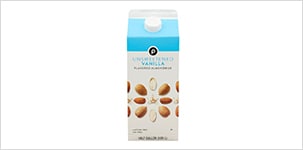Are you trying to decide between dairy and nondairy foods and beverages? The 2020–2025 Dietary Guidelines for Americans recommends low-fat and fat-free dairy, such as milk, cheese, and yogurt, as part of healthy eating styles. Yet many consumers are switching to plant-based nondairy items made from almond, coconut, and soy. It’s important to note that these options may not provide the same nutritional value as cow’s milk-based dairy products.
Discover the differences between dairy and nondairy—along with tips on making wise choices to get the nutrients you need.

Cow’s Milk vs. Nondairy Beverages
Besides its origin, what makes cow’s milk different from nondairy beverages? Milk has a consistent composition and nutritional profile according to its standard of identity—an FDA regulation that establishes the criteria for a product to be labeled as a certain food.1 The composition and nutritional profile of plant-based nondairy beverages, such as almondmilk, vary by brand since these products do not have standards of identity.2
Nutrition and Dairy Substitutes
When considering nondairy beverages as alternatives to cow’s milk, be sure to compare these nutrients:
-
Sugar – Unsweetened cow’s milk contains naturally occurring sugar,3 while many plant-based beverages and flavored cow’s milk contain added sugar. Be sure to read labels, look for unsweetened varieties, and spot our Better Choice shelf tags to help you choose options with less added sugar.
-
Vitamins and minerals – Cow’s milk naturally contains protein, calcium, vitamin D, and other nutrients. Many nondairy beverages are fortified with vitamins and minerals that do not occur naturally.2 Calcium, potassium, vitamin D, and other nutrients may be added at varying levels, depending upon the brand and type of dairy alternative. Check the labels to see which nutrients and how much of them each product contains.
Shake, shake, shake! Give nondairy beverages a good shake before using them; the calcium often settles into the bottom of the container.
-
Protein – Cow’s milk provides 8 grams of high-quality protein per 8-ounce serving. Almond, cashew, coconut, and rice beverages offer little or no protein: 0–1 gram per 8-ounce serving. If you’re drinking nondairy beverages, it’s essential to find other sources of protein.2
Power up! Find out how to get a variety of quality proteins.
Why Dairy Is Important for Kids
Experts agree that cow’s milk and other dairy products are essential to children’s diets. According to a joint statement by the Academy of Nutrition and Dietetics, the American Academy of Pediatric Dentistry, the American Academy of Pediatrics, and the American Heart Association, plant-based nondairy beverages should not be the main beverages for young children.4
Milk’s key nutrients—including protein, calcium, and vitamin D—are important for healthy growth and development in kids. If your child has a dairy or cow’s milk allergy, lactose intolerance, or religious dietary restrictions, or follows a vegan diet, be sure to consult with a pediatrician to determine the best way to get those key nutrients from other sources.5
Yogurt for You
More yogurts made from nondairy foods—such as soy, almond, and coconut—are appearing on our shelves. Once again, it’s a good idea to check the labels and choose varieties with less saturated fat and added sugar. Also, make sure they are fortified with calcium.
Yogurt makes a great snack and an excellent recipe ingredient. Try our Bronzed Chicken and Broccoli over Rice, which features plain unsweetened almondmilk yogurt.
Cheese, Please
If you’re looking for plant-based or vegan cheeses, find them in our Produce department. Don’t forget to consult the labels for options with less sodium and saturated fat, and more calcium. Nut- and soy-based cheeses tend to be lower in calcium than dairy-based cheeses, so choose brands that are calcium-fortified. Otherwise, be sure to include other sources of calcium in your diet.
Just Desserts
Treat yourself to vegan or plant-based desserts with less saturated fat and added sugar. Instead of traditional ice cream, opt for sorbet, which is dairy-free. Enjoy it in our refreshing Raspberry Iced Tea Swirl recipe—perfect for summer!
Plant-Based Sources of Calcium6
It’s possible to get the recommended daily amount of calcium (1,300 milligrams for adults and children 4 and older) through a combination of plant-based sources. Work in vegetables such as Chinese cabbage/bok choy, kale, and broccoli. Pick up calcium-fortified foods such as orange juice, tofu, and cereal. While most grains do not contain high amounts of calcium unless they are fortified, they do contain small amounts of calcium that may add up if you consume a lot of grains. The following chart can help you keep track of your daily calcium intake.
| Food or Beverage | Amount | Calcium (mg) |
|---|---|---|
| Orange juice, calcium-fortified | 6 ounces | 261 |
| Tofu, made with calcium sulfate | 1/2 cup | 138–253 |
| Ready-to-eat cereal, calcium-fortified | 1 cup | 100–1,000 |
| Turnip greens, boiled | 1/2 cup | 99 |
| Kale, cooked | 1 cup | 94 |
| Chinese cabbage/bok choy, shredded | 1 cup | 74 |
| Bread, white | 1 slice | 73 |
| Bread, whole wheat | 1 slice | 30 |
| Broccoli, raw | 1/2 cup | 21 |
Vitamin D Beyond Dairy7
The recommended daily amount of vitamin D is 20 micrograms. Very few foods contain vitamin D naturally—fish such as swordfish, salmon, tuna, and sardines are among the best sources. Beef liver, cheese, and egg yolks provide small amounts. Many breakfast cereals and some brands of orange juice are fortified with vitamin D. Use the chart below to help plan your diet.
| Food | Amount | mcg per serving | % DV |
|---|---|---|---|
| Swordfish, cooked | 3 oz | 14 | 70 |
| Salmon (sockeye), cooked | 3 oz | 11 | 55 |
| Tuna fish, canned in water, drained | 3 oz | 4 | 20 |
| Orange juice, fortified with vitamin D* | 1 cup | 3 | 15 |
| Sardines, canned in oil, drained | 2 sardines | 1 | 5 |
| Eggs (vitamin D is in yolk) | 1 large | 1 | 5 |
| Ready-to-eat cereal, fortified with 10% DV vitamin D* | 3/4–1 cup | 1 | 5 |
*Check labels, as amount added varies by product.
Filling the Gaps with Supplements
If you are eliminating or reducing dairy, fish, or eggs in your diet, it may be wise to take supplements to help ensure you are getting enough calcium and vitamin D. While multivitamin-mineral supplements often contain calcium and vitamin D, the amounts vary by product. Depending on your needs, you may consider dietary supplements that contain only calcium or calcium with other nutrients such as vitamin D.
Calcium tip! Keep in mind that calcium absorption is best when you consume 500 milligrams or less at one time. So if you plan to take 1,000 milligrams of calcium supplements per day, for example, you should split the dose rather than take it all at once.
Talk to your healthcare provider to determine which supplements, if any, are right for you.
For the Love of You
Choosing how you eat is uniquely personal. It’s about your needs, your preferences, and your goals. As your wellness ally, we’re in your corner with fresh ideas, recipes, and wellness icons that make it easier to shift toward wiser food choices. It’s all about you, at your very best.
Sources
1 Food and Drugs, 21 C.F.R. § 131.110 (2020).
2 Miller, Gregory, PhD, FACN. Ask Dr. Dairy: What's the Difference Between Cow's Milk and Plant-Based Alternatives? National Dairy Council. January 15, 2018.
3 National Dairy Council. Does Milk Have Sugar? DairyGood.org. Accessed March 13, 2020.
4 Robert Wood Johnson Foundation. Leading Health Organizations Support First-Ever Consensus Recommendations to Encourage Young Children's Consumption of Healthy Drinks. Healthy Eating Research. September 18, 2019.
5 Porto, Anthony, MD, MPH, FAAP, and Rachel Drake, MS, RD, CSO, CSP, CDN. Cow's Milk Alternatives: Parent FAQs. HealthyChildren.org: American Academy of Pediatrics. October 13, 2017.
6 U.S. Department of Health & Human Services (HHS). Calcium Fact Sheet for Health Professionals. National Institutes of Health (NIH): Office of Dietary Supplements. February 14, 2020.
7 U.S. Department of Health & Human Services (HHS). Vitamin D Fact Sheet for Health Professionals. National Institutes of Health (NIH): Office of Dietary Supplements. August 7, 2019.

 You are about to leave publix.com and enter the Instacart site that they operate and control. Publix’s delivery and curbside pickup item prices are higher than item prices in physical store locations. Prices are based on data collected in store and are subject to delays and errors. Fees, tips & taxes may apply. Subject to terms & availability. Publix Liquors orders cannot be combined with grocery delivery. Drink Responsibly. Be 21. For prescription delivery, log in to your pharmacy account by using the Publix Pharmacy app or visiting
You are about to leave publix.com and enter the Instacart site that they operate and control. Publix’s delivery and curbside pickup item prices are higher than item prices in physical store locations. Prices are based on data collected in store and are subject to delays and errors. Fees, tips & taxes may apply. Subject to terms & availability. Publix Liquors orders cannot be combined with grocery delivery. Drink Responsibly. Be 21. For prescription delivery, log in to your pharmacy account by using the Publix Pharmacy app or visiting 


